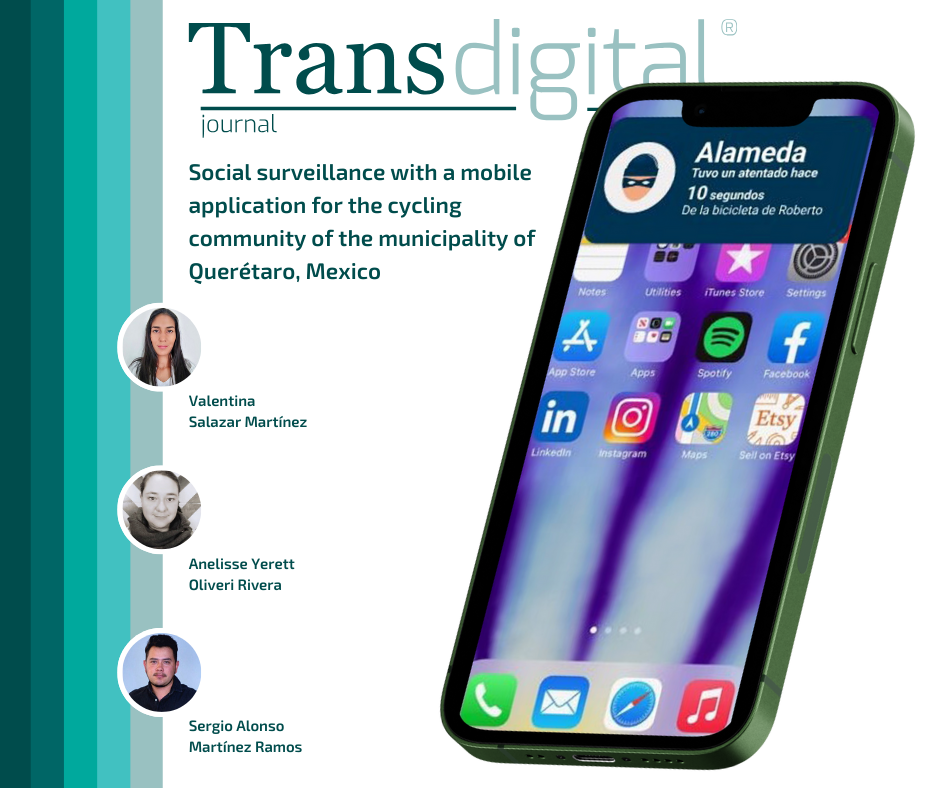Social surveillance with a mobile application for the cycling community of the municipality of Querétaro, Mexico
DOI:
https://doi.org/10.56162/transdigital291Keywords:
social surveillance, public space, cycling community, design, mobile applicationAbstract
Social surveillance has been a concept limited only to the surveillance carried out by people before State entities, thus reducing its multiple possibilities as it is an activity that is also practiced in built environments. This article explores the relationship between social surveillance of people and the promotion of safe spaces, focusing on the context of cyclists. Through a qualitative approach, a mobile application was developed designed to report on the areas most susceptible to bicycle theft when they are at rest parked in public spaces. Additionally, the application issues both primary and secondary alerts to notify users about the vulnerability of their bicycle, which encourages communication, social networking, and strengthening the cycling community in the municipality of Querétaro. The development process was based on the User-Centered Design methodology and a prototype was created using the Figma, Inc. tool. There was collaboration from various cycling groups, including Saca la Bici, A. C., Bicirobo QRO and individual cyclists. They contributed their knowledge as active urban cyclists and validated the application's graphical user interface through focus groups, with a non-probabilistic convenience sample of 20 cyclists. The results obtained in this initial phase will be used in subsequent stages of research.
References
Aguilar Carrasco, J. I., Cuevas Torres, O. M., & García López, I. F. (2023). Desarrollo de una aplicación móvil tipo luxómetro considerando los niveles mínimos de iluminación establecidos en la Norma Oficial Mexicana 025 STPS 2008. Transdigital, 4(7), 1–23. https://doi.org/10.56162/transdigital183
Borja i Sebastià, J., & Muxi Martínez, Z. (2003). El espacio público: ciudad y ciudadanía. Electa.
Chen, P., Liu, Q., & Sun, F. (2018). Bicycle parking security and built environments. Transportation Research Part D: Transport and Environment, Volume 62, 169-178. https://doi.org/10.1016/j.trd.2018.02.020
Ciuró, J., Jiménez, J. F., Moura, L., & Camargos, G. (2020). Impacto económico y social de Android en México. Android/Bain & Company. https://www.bain.com/contentassets/a9200a057a0241b8963c05a9b09e33fe/impacto-economico-y-social-de-android-en-mexico-1.pdf
Dinero. (2020). Alarma por escasez mundial de bicicletas durante pandemia. Semana. https://www.dinero.com/empresas/articulo/escasez-mundial-de-bicicletas/293417
Dwivedi, S. K., Upadhyay, S., & Tripathi, A. K. (2012). A working Framework for the User-Centered Design Approach and a Survey of the available Methods. International Journal of Scientific and Research Publications 2(4), 1-8. https://www.ijsrp.org/research_paper_apr2012/ijsrp-apr-2012-05.pdf
Ferrando, H. (coord.) (s/f). Manual de aparcamientos de bicicletas. Instituto para la Diversificación y Ahorro de la Energía. https://www.idae.es/uploads/documentos/documentos_Manual_de_aparcamientos_de_bicicletas_edf1ed0e.pdf
Goleman, D. (2006). Inteligencia social: la nueva ciencia de las relaciones humanas. Kairós.
Graizbord, B., & Montero, F. (Eds.) (2011). Megaciudades y cambio climático. Ciudades sostenibles en un mundo cambiante. El Colegio de México.
Harari, Y. N. (2014). Sapiens. De animales a dioses: breve historia de la humanidad. Debate.
INEGI / SCT / IFT. (2021). Comunicado de prensa Núm. 352/21. Instituto Nacional de Estadística y Geografía, Secreataría de Comunicaciones y Transporte, Instituto Federal de Telecomunicaciones. https://www.inegi.org.mx/contenidos/saladeprensa/boletines/2021/OtrTemEcon/ENDUTIH_2020.pdf
INEGI. (2020). Cuéntame de México. Población. Instituto Nacional de Estadística y Geografía. https://cuentame.inegi.org.mx/poblacion/habitantes.aspx?tema=P
INEGI. (2022). Estadísticas a propósito del día internacional de la juventud. Comunicado de prensa Núm. 436/22. Instituto Nacional de Estadística y Geografía. https://www.inegi.org.mx/contenidos/saladeprensa/aproposito/2022/EAP_Juventud22.pdf
Morville, P. (2004). User Experience Design. Semantics Studio. http://semanticstudios.com/publications/semantics/000029.php
Nettle, D., Nott, K., & Bateson, M. (2012) ‘Cycle Thieves, We Are Watching You’: Impact of a Simple Signage Intervention against Bicycle Theft. PLoS ONE, 7(12), e51738. https://doi.org/10.1371/journal.pone.0051738
Segura Amaro, P. (2022). Iniciativa “bici robo” Ciclistas crean padrón de bicis robadas en Querétaro; van 58 hurtos en el primer trimestre del año. Vía Tres : https://www.viatres.com.mx/queretaro/2022/4/17/ciclistas-crean-padron-de-bicis-robadas-en-queretaro-van-58-hurtos-en-el-primer-trimestre-del-ano-6731.html
Sidebottom, A., Thorpe, A., & Johnson, S. D. (2009). Using Targeted Publicity to Reduce Opportunities for Bicycle Theft. A Demonstration and Replication. European Journal of Criminology, 6(3), 267-286. https://journals.sagepub.com/doi/abs/10.1177/1477370809102168

Downloads
Autor de correspondencia
El autor de correspodencia se identifica con el siguiente símbolo: *Published
How to Cite
License
Copyright (c) 2024 Valentina Salazar Martínez, Anelisse Yerett Oliveri Rivera, Sergio Alonso Martínez Ramos

This work is licensed under a Creative Commons Attribution 4.0 International License.
All articles in Transdigital are licensed under a Creative Commons Attribution 4.0 International License. Authors hold the copyright and retain publishing rights without restrictions.









